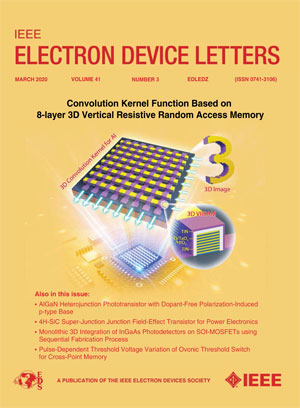具有极性控制的均匀单层WSe 2通道低功耗CMOS逆变器
IF 4.1
2区 工程技术
Q2 ENGINEERING, ELECTRICAL & ELECTRONIC
引用次数: 0
摘要
虽然创新技术节点的性能指标继续快速提高,但能源效率却没有跟上。在这项工作中,我们成功地使用单层二硒化钨(WSe2)构建了一个均匀的CMOS逆变器,这是一种有希望的候选材料,可以在原子级厚度上保持良好的迁移率,并提供更好的抗短通道效应。通过不同的接触工程和钝化掺杂方法,可以有效地定制WSe2的极性。这些模块的改进有助于研究低有效氧化厚度背栅介质对n型和p型场效应晶体管在增强模式下几个关键工艺步骤的阈值电压和匹配性能的影响。此外,逆变器在相关电源电压(VDD)为1.5 V时表现出优异的性能:电压增益超过10 V/V,噪声裕度超过80%,皮瓦范围的静态功耗,以及接近理想的半VDD开关电压。同时达到这些数字为下一代二维材料电子元件的应用开辟了可能性。本文章由计算机程序翻译,如有差异,请以英文原文为准。
Low-Power CMOS Inverter Using Homogeneous Monolayer WSe₂ Channel With Polarity Control
While performance metrics of innovative technology-nodes continue to improve rapidly, energy efficiency has not kept pace. In this work, we successfully constructed a homogeneous CMOS inverter using monolayer tungsten diselenide (WSe2, a promising candidate can maintain good mobility at atomic-level thickness and offers better resistance to short-channel effects. Through different contact engineering and passivation doping approaches, the polarity of WSe2 could be effectively tailored. These module improvements are helpful to investigate the impact on threshold voltage of several critical process steps and match performance of both n and p-type field-effect transistors with low effective oxide thickness back-gate dielectrics in enhancement-mode operation. In addition, the inverters demonstrate superior performance at a relevant supply voltage (VDD) of 1.5 V: voltage gain exceeding 10 V/V, noise margin over 80%, picowatt-range static-power consumption, and near-ideal switching voltage of half-VDD. Reaching these numbers simultaneously opens up the possibilities for future-generation applications of two-dimensional material-based electronic components.
求助全文
通过发布文献求助,成功后即可免费获取论文全文。
去求助
来源期刊

IEEE Electron Device Letters
工程技术-工程:电子与电气
CiteScore
8.20
自引率
10.20%
发文量
551
审稿时长
1.4 months
期刊介绍:
IEEE Electron Device Letters publishes original and significant contributions relating to the theory, modeling, design, performance and reliability of electron and ion integrated circuit devices and interconnects, involving insulators, metals, organic materials, micro-plasmas, semiconductors, quantum-effect structures, vacuum devices, and emerging materials with applications in bioelectronics, biomedical electronics, computation, communications, displays, microelectromechanics, imaging, micro-actuators, nanoelectronics, optoelectronics, photovoltaics, power ICs and micro-sensors.
 求助内容:
求助内容: 应助结果提醒方式:
应助结果提醒方式:


